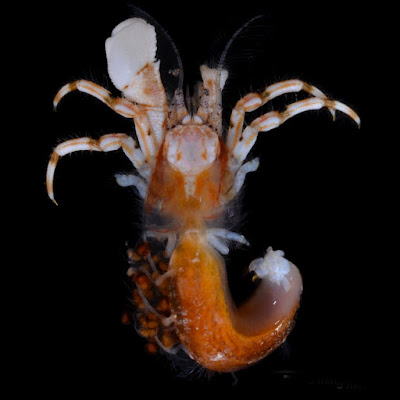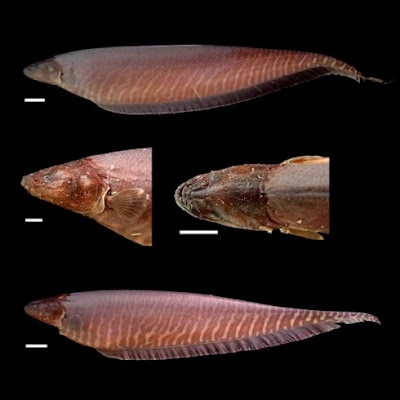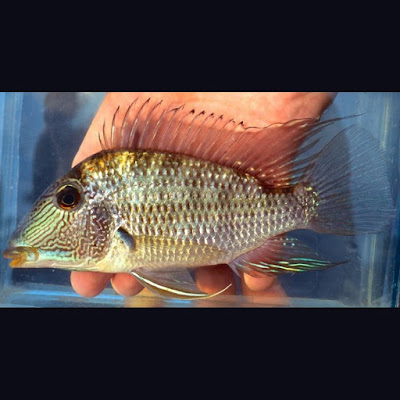[Most Recent Entries] [Calendar View]
Wednesday, February 14th, 2018
| Time | Event | ||||
| 2:20a | [Crustacea • 2018] Diogenes albimanus • A New Species of the Hermit Crab Genus Diogenes (Decapoda: Diogenidae) from the Coast of KwaZulu-Natal, South Africa
Abstract A new diogenid hermit crab with bright-white chelae, Diogenes albimanus n. sp., is described and illustrated, based on a single ovigerous female collected from KwaZulu-Natal, South Africa. The new species is compared to morphologically similar species, in particular to D. holthuisi and D. dorotheae, from which it is distinguishable by the shape and armature of the telson; and also to the superficially-similar South African D. extricatus, from which it differs by having the unarmed dorsal margins of the propodi and meri of the pereopods, as opposed to being armed with rows of strong spines. The unusually white chelae are similar in colour to those of D. takedai, but the coloration of all other parts is different in these two species. High quality macro photographs, a high-resolution microCT (μCT) scan of the whole animal, and the reference to the repository of the molecular barcode of the new species are provided. Keywords: Crustacea, Crustacean, Diogenes, rocky reef, southwestern Indian Ocean Jannes Landschoff and Dwi Listyo Rahayu. 2018. A New Species of the Hermit Crab Genus Diogenes (Crustacea: Decapoda: Diogenidae) from the Coast of KwaZulu-Natal, South Africa. Zootaxa. 4379(2); 268–278. DOI: 10.11646/zootaxa.4379.2.7 | ||||
| 9:24a | [Ichthyology • 2018] Gymnotus cuia • Revision of Banded Knifefishes of the Gymnotus carapo and G. tigre clades (Gymnotidae Gymnotiformes) from the Southern Neotropics
Abstract Banded Knifefishes (Gymnotus, Gymnotidae) comprise the most species-rich, ecologically tolerant (eurytopic), and geographically widespread genus of Neotropical electric fishes (Gymnotiformes), with 40 valid species occupying most habitats and regions throughout the humid Neotropics. Despite substantial alpha-taxonomic work in recent years, parts of the genus remain characterized by taxonomic confusion. Here we describe and delimit species of the G. carapo and G. tigre clades from the southern Neotropics, using body proportions (caliper-based morphometrics), fin-ray, scale and laterosensory-pore counts (meristics), quantitative shape differences (geometric morphometrics), osteology, color patterns and electric organ discharges. We report these data from 174 Gymnotus specimens collected from 100 localities throughout the southern Neotropics, and delimit species boundaries in a multivariate statistical framework. We find six species of the G. carapo clade (G. carapo australis, Gymnotus cuia n. sp., G. chimarrao, G. omarorum, G. pantanal, and G. sylvius), and two species of the G. tigre clade (G. inaequilabiatus and G. paraguensis) in the southern Neotropics. The new species G. cuia is readily distinguished from the morphologically similar and broadly sympatric G. c. australis by a shorter head and deeper head and body, and from the morphologically similar and sympatric G. omarorum by fewer lateral-line ventral rami and fewer pored lateral-line scales anterior to the first ventral ramus. We also review the geographic distributions of all eight species of the G. carapo and G. tigre clades in the southern Neotropics, showing that G. cuia is the most widespread species in the region. These results affirm the importance of understanding the structure of variation within and between species, both geographic and ontogenetic, in delimiting species boundaries. Keywords: Pisces, Alpha taxonomy, Biodiversity assessment, Neotropical, Species delimitation
Gymnotus cuia n. sp. G. aff. carapo — (Bertaco et al. 2016; Cognato et al. 2007a; b; Cognato & Fialho 2006; Malabarba et al. 2013; Serra et al. 2014). Etymology: The specific epithet is derived from the species’ especially deep body and head, evoking the short, rounded cuia gourd used to drink the traditional mate popular throughout its range. The convention of honoring this practice in gymnotiform taxonomy is shared with G. chimarrao (chimarrão =the mate itself) and Brachyhypopomus bombilla (bombilla = the metal straw used for drinking mate). The common name “ bombilla ” is often used to describe gymnotiform fish throughout the southern Neotropics as well. Ecology: Gymnotus cuia inhabits lakes and small streams, associated to densely vegetated areas. The species is abundant in the type locality (Figure 9), a shallow lake (less than 1 m deep) with dense emergent vegetation, including Ludwigia peploides (Onagraceae), Utricularia spp. (Lenticulariaceae), Nymphoides indica (Menyanthaceae), Pontederia lanceolata (Pontederiaceae), Azolla sp. (Azollaceae), Eleocharis sp. (Cyperaceae), Cabomba australis (Cabombaceae), Echinodorus sp. (Alismataceae), Lemna valdiviana (Lemnaceae), Scirpus sp. (Sciperaceae) and abundant grass in the shores (Cognato & Fialho 2006). Throughout its distribution it is usually abundant in the roots of dense beds of floating water hyacinths (Eichornia crassipes). Reproductive cycle extends from November to March (Cognato & Fialho 2006). Jack M. Craig, Luiz R. Malabarba, William G. R. Crampton and James S. Albert. 2018. Revision of Banded Knifefishes of the Gymnotus carapo and G. tigre clades (Gymnotidae Gymnotiformes) from the Southern Neotropics. Zootaxa. 4379(1); 47–73. DOI: 10.11646/zootaxa.4379.1.3 | ||||
| 9:43a | [Ichthyology • 2018] Satanoperca curupira • A New Cichlid Species from the rio Madeira Basin (Teleostei: Cichlidae) in Brazil
Abstract Satanoperca curupira, new species, is described from the rio Madeira basin in the State of Rondônia, Brazil. It is distinguished from all congeners by the following combination of characters: 3–7 dark-brown oblique stripes on the lachrymal (vs. 2 well-defined dark-brown stripes, or dark-brown stripes absent) and an irregular pattern of dark-brown stripes on cheek and opercular series (vs. cheek without dark-brown markings or with light-beige rounded spots). According to meristic and color pattern characters, the new species is considered a member of the S. jurupari species group, and is syntopic with S. jurupari, which is widespread in the Amazon basin. The restricted geographical range of the new species is congruent to that observed for some other Satanoperca species. Keywords: Pisces, Geophaginae, Neotropical region, Satanoperca jurupari species-group, taxonomy
Satanoperca curupira, new species Satanoperca sp. “Jaru” —. Weidner 2000: 243 (photograph of living specimen). Satanoperca jurupari —. Stawikowski & Werner 2004: 404 (photograph of living specimen) —. Graça et al. 2013: 373 (in part; lots UFRO-I 7869 and UFRO-I 11589). Distribution. Satanoperca curupira is known from the rio Madeira basin in Brazil, occurring in the main channel of the rio Madeira and in several tributaries draining the Brazilian shield (rio Jaciparaná, rio Jamari, rio Jaru and rio Machado), and also at the rio Roosevelt (a tributary of the rio Aripuanã), and at the rio São Luis (a tributary of the rio Guaporé) (Fig. 5). Etymology. The specific name curupira refers to a mythological creature of Brazilian folklore that protects the forest and its inhabitants, punishing those who hunt for pleasure or who kill breeding females or defenseless juveniles (Pereira 1994). The Curupira legend reveals the relationship between the indigenous people and the forest: it is not about exploration and indiscriminate use, but respect for life. A noun in apposition. Renata R. Ota, Sven O. Kullander, Gabriel C. Deprá, Weferson J. da Graça and Carla S. Pavanelli. 2018. Satanoperca curupira, A New Cichlid Species from the rio Madeira basin in Brazil (Teleostei: Cichlidae). Zootaxa. 4379(1);103–112. DOI: 10.11646/zootaxa.4379.1.6 |
| << Previous Day |
2018/02/14 [Calendar] |
Next Day >> |







